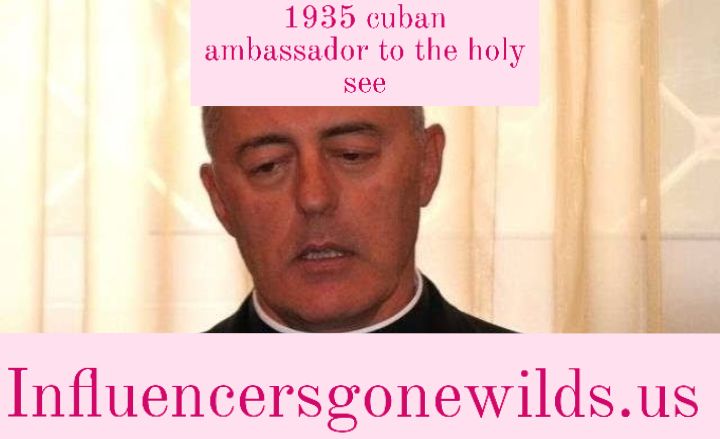Introduction
In the realm of diplomacy and international relations, the role of an ambassador is crucial in fostering communication, collaboration, and mutual understanding between nations. One particular appointment in the annals of history that stands out is the appointment of the 1935 cuban ambassador to the holy see . This event represents not only the evolution of Cuba’s diplomatic reach but also reflects the intricate relationship between the Catholic Church and the governments across the world during the early 20th century. Understanding the context of the time, the political situation in Cuba, and the significance of the role of the ambassador provides valuable insights into the broader framework of international diplomacy and how it shaped the geopolitical landscape of the era.
The Vatican, under the leadership of Pope Pius XI, was carefully navigating the political landscape of Europe, seeking to protect the interests of the Catholic Church while maintaining its influence in global affairs. For Cuba, a country in the Americas with strong historical ties to Catholicism, the appointment of an ambassador to the Holy See was a diplomatic gesture that underscored the importance of maintaining ties with the Vatican in this rapidly changing global environment.
Historical Context and Geopolitical Landscape of the 1930s
To fully understand the significance of the 1935 cuban ambassador to the holy see , it is essential to consider the historical context of the time. The early 20th century was a period of significant political upheaval and change for Cuba. Following its independence from Spain in 1898, Cuba had struggled with political instability, economic challenges, and foreign intervention, particularly from the United States. By the 1930s, the country was under the control of President Gerardo Machado, whose government had come to power through a military coup. Machado’s regime, which began in 1925, was marked by authoritarian rule, widespread corruption, and growing discontent among the Cuban population.
In the midst of this political turmoil, Cuba sought to establish itself as a legitimate actor in the international arena. One way to achieve this was through diplomatic engagement with key global institutions, including the Vatican. The Catholic Church had a long-standing presence in Latin America, and its influence extended far beyond religious matters. The Vatican’s role as a political and diplomatic actor was particularly important in the 1930s, as Europe was grappling with the rise of fascism and the growing tensions between European powers. For Cuba, maintaining a positive relationship with the Holy See was seen as a way to enhance its standing in the international community, as well as to solidify its cultural and religious identity as a predominantly Catholic nation.
The Role of the Cuban Ambassador to the Holy See
The 1935 cuban ambassador to the holy see was a significant step for Cuba, as it marked the formalization of diplomatic relations between the two entities. The role of the ambassador was not only ceremonial but also served as a conduit for communication between the Cuban government and the Vatican. The ambassador’s duties would have included representing Cuba’s interests at the Holy See, facilitating dialogue on matters of mutual concern, and working to strengthen the political, religious, and cultural ties between the two entities.
One of the key aspects of the ambassador’s role would have been to foster cooperation between Cuba and the Vatican on issues related to Catholicism, education, and social policy. The Catholic Church had a profound influence on Cuban society, particularly in the areas of education and social welfare. The ambassador’s position would have been vital in ensuring that Cuba maintained a positive relationship with the Vatican, especially as the Church sought to assert its influence in Latin America during the 1930s.
In addition to his diplomatic responsibilities, the ambassador to the Holy See would have also played a role in promoting Cuban culture and values within the Vatican.
The appointment of a Cuban ambassador to the Holy See was not only a symbolic gesture but also a strategic move by the Cuban government to solidify its ties with the Vatican and the wider Catholic world. It reflected a recognition of the importance of diplomacy in maintaining national sovereignty and advancing national interests on the global stage.
Diplomatic and Religious Significance
The 1935 cuban ambassador to the holy see also had significant religious and diplomatic implications. Pope Pius XI, who led the Vatican during this period, was concerned with preserving the independence and moral authority of the Church in an increasingly secular and politically charged world. As such, the Vatican maintained a delicate balance in its diplomatic relations with various governments, including those in Latin America.
Cuba, as a predominantly Catholic country, shared many of the same religious values and concerns as the Vatican. The Cuban government’s decision to appoint an ambassador to the Holy See was, in many ways, an acknowledgment of the Vatican’s influence in the region and a reflection of Cuba’s desire to maintain strong religious ties. The ambassador’s role would have involved engaging with the Vatican on issues related to Catholicism, as well as addressing any concerns or challenges that arose between the Cuban government and the Church.
In addition to its religious significance, the appointment of the Cuban ambassador to the Holy See also had diplomatic implications for Cuba’s broader foreign policy. By strengthening its ties with the Vatican, Cuba sought to enhance its standing in the international community and improve its relationships with other Catholic nations. The appointment signaled Cuba’s commitment to maintaining a strong presence in international diplomacy, despite the internal challenges it faced.
Conclusion
The appointment of the Cuban Ambassador to the 1935 cuban ambassador to the holy see represents a pivotal moment in Cuba’s diplomatic history. It highlights the country’s efforts to establish itself as a legitimate actor on the world stage, despite the political instability and challenges it faced at home. The role of the ambassador was not only to represent Cuba’s interests in matters of diplomacy but also to strengthen the cultural, religious, and political ties between Cuba and the Vatican.
In a broader sense, the appointment reflects the importance of diplomacy in shaping the relationships between nations and global institutions. As Cuba navigated the complexities of the 1930s, the appointment of an ambassador to the Holy See served as a symbol of the country’s commitment to maintaining strong international ties and asserting its place in the global community.
FAQs
What was the significance of Cuba’s appointment of an ambassador to the Holy See in 1935?
The appointment marked a significant step in Cuba’s diplomatic history, symbolizing the country’s desire to strengthen its relationship with the Vatican and assert its presence on the global stage. It reflected Cuba’s recognition of the Vatican’s influence in Latin America and its efforts to maintain strong diplomatic ties with Catholic nations.
Why did Cuba want to maintain strong ties with the Vatican?
As a predominantly Catholic nation, Cuba shared cultural and religious values with the Vatican.
How did the appointment of an ambassador to the Holy See impact Cuba’s international relations?
The appointment helped solidify Cuba’s standing as a legitimate player in global diplomacy, particularly in its relationships with other Catholic nations. It allowed Cuba to engage more effectively with the Vatican and participate in international discussions on religious and political issues.
Also Read This: 1935 Cuban Ambassador to the Holy See: A Historical Insight


